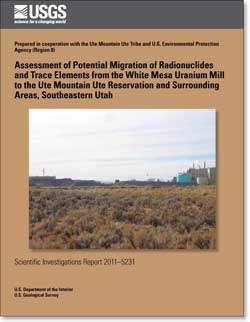 Abstract
Abstract
In 2007, the Ute Mountain Ute Tribe requested that the U.S. Environmental Protection Agency and U.S. Geological Survey conduct an independent evaluation of potential offsite migration of radionuclides and selected trace elements associated with the ore storage and milling process at an active uranium mill site near White Mesa, Utah. Specific objectives of this study were (1) to determine recharge sources and residence times of groundwater surrounding the mill site, (2) to determine the current concentrations of uranium and associated trace elements in groundwater surrounding the mill site, (3) to differentiate natural and anthropogenic contaminant sources to groundwater resources surrounding the mill site, (4) to assess the solubility and potential for offsite transport of uranium-bearing minerals in groundwater surrounding the mill site, and (5) to use stream sediment and plant material samples from areas surrounding the mill site to identify potential areas of offsite contamination and likely contaminant sources.
The results of age-dating methods and an evaluation of groundwater recharge temperatures using dissolved-gas samples indicate that groundwater sampled in wells in the surficial aquifer in the vicinity of the mill is recharged locally by precipitation. Tritium/helium age dating methods found a “modern day” apparent age in water samples collected from springs in the study area surrounding the mill. This apparent age indicates localized recharge sources that potentially include artificial recharge of seepage from constructed wildlife refuge ponds near the mill. The stable oxygen isotope-ratio, delta oxygen-18, or δ(18O/16O), known as δ18O, and hydrogen isotope-ratio, delta deuterium, or δ(2H/1H), known as δD, data indicate that water discharging from Entrance Spring is isotopically enriched by evaporation and has a similar isotopic fingerprint as water from Recapture Reservoir, which is used as facilities water on the mill site. Water from Recapture Reservoir also is used to irrigate fields surrounding the town of Blanding and infiltration of this irrigated water also could contribute to the enriched isotopic fingerprint observed for Entrance Spring. Similarities in the delta sulfur-34sulfate values in water samples from the wildlife ponds and tailings cells indicate a potential contaminant linkage between the tailings cells and the refuge ponds that could be related to wind carried (eolian) transport of aerosols from the tailings cells. To date (2010), neither the delta sulfur-34sulfate nor the delta oxygen-18sulfate values measured in the wells and springs surrounding the uranium mill site have an isotopic signature characteristic of water from the tailings cells.
Except for Entrance Spring and Mill Spring, all groundwater samples collected at down-gradient sample sites during this study had dissolved-uranium concentrations in the range expected for naturally-occurring uranium. The uranium-isotope data indicate that the mill is not a source of uranium in the groundwater in the unconfined-aquifer at any site monitored during the study, with the possible exception of Entrance Spring. The uranium-234 to uranium-238 concentration activity ratios measured in water samples collected at Entrance Spring, and the decrease in this ratio associated with an increase in the concentration of dissolved uranium indicate potential mixing of uranium ore with groundwater at the spring through eolian transport of small particles from ore-storage pads and uncovered ore trucks, with subsequent deposition in the Entrance Spring drainage, followed by dissolution in the unconfined groundwater. The isotopic values of uranium found in other water samples collected during the study do not appear to be related to uranium ore deposits.
Water samples collected from Entrance Spring contained the highest median uranium concentrations relative to water samples collected from the other wells and springs monitored during the study. Water samples collected from Entrance Spring also contained elevated concentrations of selenium and vanadium. Sediment samples collected from three ephemeral drainages east of the uranium mill site (including Entrance Spring) contained uranium concentrations exceeding background values downwind of the predominant wind directions at the site. Sediment samples collected from ephemeral drainages on the south and west boundaries of the uranium mill site generally did not exceed background-uranium concentrations. Elevated concentrations of uranium and vanadium, indicating offsite transport, were found in plant tissue samples collected north-northeast, east, and south of the mill site, downwind of
2 Assessment of potential migration of radionuclides and trace elements from the White Mesa uranium mill
the predominant wind directions at the site. The uranium and vanadium concentrations in plant tissue samples collected west of the uranium mill site were low.
On the basis of the study results, consideration should be given to future monitoring programs in areas surrounding the uranium mill site to address current and future environmental concerns. These potential monitoring programs should consider (1) quarterly monitoring of major- and trace-element concentrations in selected springs and wells; (2) annual monitoring of Entrance Spring for uranium isotopes, delta sulfur-34sulfate, delta oxygen-18, and delta deuterium; (3) annual monitoring of background water quality at selected spring and monitoring well sites; (4) periodic sampling and chemical analyses of sagebrush in areas east of the uranium mill site coupled with off-site fugitive dust monitoring; (5) installation of a new monitoring well upgradient from the East and West wells; (6) the addition of non-routine chemical constituents to ongoing monitoring programs within the uranium mill site that could provide additional insight(s) into potential contaminant sources and processes; and (7) archiving future monitoring data into a maintained database that is easily accessible to all project stakeholders.